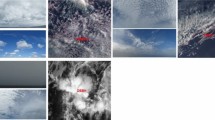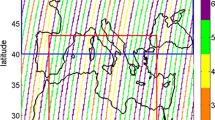Abstract
Knowledge of cloud vertical structure is important for meteorological and climate studies due to the impact of clouds on both the Earth’s radiation budget and atmospheric adiabatic heating. Yet it is among the most difficult quantities to observe. In this study, we develop a long-term (10 years) radiosonde-based cloud profile product over the Southern Great Plains and along with ground-based and space-borne remote sensing products, use it to evaluate cloud layer distributions simulated by the National Centers for Environmental Prediction global forecast system (GFS) model. The primary objective of this study is to identify advantages and limitations associated with different cloud layer detection methods and model simulations. Cloud occurrence frequencies are evaluated on monthly, annual, and seasonal scales. Cloud vertical distributions from all datasets are bimodal with a lower peak located in the boundary layer and an upper peak located in the high troposphere. In general, radiosonde low-level cloud retrievals bear close resemblance to the ground-based remote sensing product in terms of their variability and gross spatial patterns. The ground-based remote sensing approach tends to underestimate high clouds relative to the radiosonde-based estimation and satellite products which tend to underestimate low clouds. As such, caution must be exercised to use any single product. Overall, the GFS model simulates less low-level and more high-level clouds than observations. In terms of total cloud cover, GFS model simulations agree fairly well with the ground-based remote sensing product. A large wet bias is revealed in GFS-simulated relative humidity fields at high levels in the atmosphere.








Similar content being viewed by others
References
Chang FL, Li Z (2005a) A new method for detection of cirrus overlapping water clouds and determination of their optical properties. J Atmos Sci 62:3993–4009
Chang FL, Li Z (2005b) A near global climatology of single-layer and overlapped clouds and their optical properties retrieved from TERRA/MODIS data using a new algorithm. J Clim 18:4752–4771
Chernykh IV, Eskridge RE (1996) Determination of cloud amount and level from radiosonde soundings. J Appl Meteorol 35:1362–1369
Chernykh IV, Alduchov OA, Eskridge RE (2000) Trends in low and high cloud boundaries and errors in height determination of cloud boundaries. Bull Am Meteor Soc 82:1941–1947
Clothiaux EE et al (1999) The atmospheric radiation measurement program cloud radars: operational modes. J Atmos Ocean Technol 16:819–827. doi:10.1175/1520-0426(1999)016<0819:TARMPC>2.0.CO;2
Clothiaux EE, Ackerman TP, Mace GG, Moran KP, Marchand RT, Miller MA, Martner BE (2000) Objective determination of cloud heights and radar reflectivities using a combination of active remote sensors at the ARM CART sites. J Appl Meteorol 39:645–665
Dong X, Mace GG (2003) Arctic stratus cloud properties and radiative forcing derived from ground-based data collected near Point Barrow, Alaska. J Clim 16:445–461
Dong X, Minnis P, Xi B (2005) A climatology of mid-latitude continental clouds from the ARM SGP central facility. Part I: low-level cloud macrophysical, microphysical, and radiative properties. J Clim 18:1391–1410
Dong X, Xi B, Minnis P (2006) A climatology of mid-latitude continental clouds from the ARM SGP central facility. Part II: cloud fraction and surface radiative forcing. J Clim 19:1765–1783
Dupont J, Haeffelin M, Morille Y, Comstock J, Flynn C, Long C, Sivaraman C, Newson R (2011) Cloud properties derived from two lidars over the ARM SGP site. Geophys Res Lett 38. doi:10.1029/2010GL046274
Kanamitsu M (1989) Description of the NMC global data assimilation and forecast system. Weather Forecast 4:335–342
Kennedy AD, Dong X, Xi B, Minnis P, Del Genio AD, Wolf AB, Khaiyer M (2010) Evaluation of the NASA GISS single-column model simulated clouds using combined surface and satellite observations. J Clim 23:5175–5192
Kollias P, Tselioudis G, Albrecht BA (2007) Cloud climatology at the Southern Great Plains and the layer structure, drizzle, and atmospheric modes of continental stratus. J Geophys Res 112. doi:10.1029/2006JD007307
Kollias P, Miller MA, Johnson KL, Jensen MP, Troyan DT (2009) Cloud, thermodynamic, and precipitation observations in West Africa during 2006. J Geophys Res 114. doi:10.1029/2008JD010641
Lazarus S, Krueger SK, Mace GG (2000) A cloud climatology of the Southern Great Plains ARM CART. J Clim 13:1762–1775
Li Z et al (2011) East Asian Studies of Tropospheric Aerosols and their Impact on Regional Climate (EASTAIRC): an overview. J Geophys Res 116. doi:10.1029/2010JD015257
Li Z, Lee KH, Wang Y, Xin J, Hao WM (2010) First observation‐based estimates of cloud‐free aerosol radiative forcing across China. J Geophys Res 115. doi:10.1029/2009JD013306
Luo Y, Krueger SK, Mace GG, Xu KM (2003) Cirrus cloud properties from a cloud-resolving model simulation compared to cloud radar observations. J Atmos Sci 60:510–525
Luo Y, Krueger SK, Moorthi S (2005) Cloud properties simulated by a single-column model. Part I: comparison to cloud radar observations of cirrus clouds. J Atmos Sci 62:1428–1445
Mace GG, Benson S (2008) The vertical structure of cloud occurrence and radiative forcing at the SGP ARM Site as revealed by 8 years of continuous data. J Clim 21. doi:10.1175/2007JCLI1987.1
Mace GG, Zhang Q, Vaughn M, Marchand R, Stephens G, Trepte C, Winker D (2009) A description of hydrometeor layer occurrence statistics derived from the first year of merged Cloudsat and CALIPSO data. J Geophys Res 114. doi:10.1029/2007JD009755
Marchand RT, Ackerman TP, King MD, Moroney C, Davies R, Muller JP, Gerber H (2001) Multiangle observations of arctic clouds from FIRE ACE: June 3, 1998, case study. J Geophys Res 106:15201–15214
Miller MA (2008) The cloud and land surface interaction campaign (CLASIC). EOS Trans AGU 89 Abstract H43D‐03
Miller MA, Johnson KL, Troyan DT, Clothiaux EE, Mlawer EJ, Mace GG (2003) ARM value‐added cloud products: description and status. http://www.arm.gov/publications/proceedings/conf13/extended_abs/miller-ma.pdf
Minnis P, Yi Y, Huang J, Ayers JK (2005) Relationships between radiosonde and RUC-2 meteorological conditions and cloud occurrence determined from ARM data. J Geophys Res 110. doi:10.1029/2005JD006005
Moran KP, Martner BE, Post MJ, Kropfli RA, Welsh DC, Widener KB (1998) An unattended cloud-profiling radar for use in climate research. Bull Am Meteor Soc 79:443–455
Naud C, Muller JP, Clothiaux EE (2003) Comparison between active sensor and radiosonde cloud boundaries over the ARM Southern Great Plains site. J Geophys Res 108. doi:10.1029/2002JD002887
Okamoto H, Nishizawa T, Takemura T, Sato K, Kumagai H, Ohno Y, Sugimoto N, Shimizu A, Matsui I, Nakajima T (2008) Vertical cloud properties in the tropical western Pacific Ocean: validation of the CCSR/NIES/FRCGC GCM by shipborne radar and lidar. J Geophys Res 113. doi:10.1029/2008JD009812
Protat A, Young SA, McFarlane S, L’Ecuyer T, Mace GG, Comstock J, Long JC, Berry E, Delanoë J (2014) Reconciling ground-based and space-based estimates of the frequency of occurrence and radiative effect of clouds around Darwin, Australia. J Appl Meteor Clim 53:456–478. doi:10.1175/JAMC-D-13-072.1
Qian Y, Long CN, Wang H, Comstock JM, McFarlane SA, Xie S (2012) Evaluation of cloud fraction and its radiative effect simulated by IPCC AR4 global models against ARM surface observations. Atmos Chem Phys 12. doi:10.5194/acp-12-1785-2012
Sela J (1980) Spectral modeling at the National Meteorological Center. Mon Weather Rev 108:1279–1292
Stephens G (2005) Cloud feedbacks in the climate system: a critical review. J Clim 18:237–273
Stephens G et al (2002) The CloudSat mission and the A-train. Bull Am Meteor Soc 83:1771–1790
Thorsen TJ, Fu Q, Comstock JM, Sivaraman C, Vaughan MA, Winker DM, Turner DD (2013) Macrophysical properties of tropical cirrus clouds from the CALIPSO satellite and from ground-based micropulse and Raman lidars. J Geophys Res 118(16):9209–9220. doi:10.1002/jgrd.50691
Tobin DC, Revercomb HE, Knuteson RO, Lesht BM, Strow LL, Hannon SE, Feltz WF, Moy LA, Fetzer EJ, Cress TS (2006) Atmospheric radiation measurement site atmospheric state best estimates for atmospheric infrared sounder temperature and water vapor retrieval validation. J Geophys Res 111. doi:10.1029/2005JD006103
Wang J, Rossow WB (1995) Determination of cloud vertical structure from upper air observations. J Appl Meteorol 34:2243–2258
Wang J, Rossow WB, Uttal T, Rozendaal M (1999) Variability of cloud vertical structure during ASTEX observed from a combination of rawinsonde, radar, ceilometer, and satellite. Mon Weather Rev 127:2482–2502
Wang J, Rossow WB, Zhang Y (2000) Cloud vertical structure and its variations from a 20-year global rawinsonde dataset. J Clim 13:3041–3056
Weare BC (1996) Evaluation of the vertical structure of zonally averaged cloudiness and its variability in the atmospheric model intercomparison project. J Clim 9:3419–3431
Winker DM, Hunt WH, McGill MJ (2007) Initial performance assessment of CALIOP. Geophys Res Lett 34:L19803. doi:10.1029/2007GL030135
Xi B, Dong X, Minnis P, Khaiyer M (2010) A 10-year climatology of cloud cover and vertical distribution derived from both surface and GOES observations over the DOE ARM SGP site. J Geophys Res 115. doi:10.1029/2009JD012800
Xie SC, Zhang MH (2000) Analysis of the convection triggering condition in the NCAR CCM using ARM measurements. J Geophys Res 105:14983–14996
Xu KM, Randall DA (1996) A semi-empirical cloudiness parameterization for use in climate models. J Atmos Sci 53:3084–3102
Xu KM et al (2002) An intercomparison of cloud-resolving models with the ARM summer 1997 intensive observation period data. Q J Roy Meteorol Soc 128:593–624
Yang F, Pan H, Krueger S, Moorthi S, Lord S (2006) Evaluation of the NCEP global forecast system at the ARM SGP site. Mon Weather Rev 134:3668–3690
Yoo H, Li Z (2012) Evaluation of cloud properties in the NOAA/NCEP global forecast system using multiple satellite products. Clim Dyn. doi:10.1007/s00382-012-1430-0
Yoo H, Li Z, You Y, Lord S, Weng F, Barker HW (2013) Diagnosis and testing of low-level cloud parameterizations for the NCEP/GFS model satellite and ground-based measurements. Clim Dyn. doi:10.1007/s00382-013-1884-8
Zhang MH et al (2005) Comparing clouds and their seasonal variations in 10 atmospheric general circulation models with satellite measurements. J Geophys Res 110. doi:10.1029/2004JD005021
Zhang Y, Klein SA (2010) Mechanisms affecting the transition from shallow to deep convection over land: inferences from observations of the diurnal cycle collected at the ARM Southern Great Plains site. J Atmos Sci 67:2943–2959
Zhang J, Chen H, Li Z, Fan X, Peng L, Yu Y, Cribb M (2010) Analysis of cloud layer structure in Shouxian, China using RS92 radiosonde aided by 95 GHz cloud radar. J Geophys Res 115. doi:10.1029/2010JD014030
Zhang J, Li Z, Chen H, Cribb M (2013) Validation of a radiosonde-based cloud layer detection method against a ground-based remote sensing method at multiple ARM sites. J Geophys Res 118. doi:10.1029/2012JD018515
Acknowledgments
Data from the US Department of Energy’s Atmospheric Radiation Measurement (ARM) Climate Research Facility located near Lamont, Oklahoma were used in this study. This work is supported by the Ministry of Science and Technology of China (2013CB955804, 2010CB950804), the National Natural Science Foundation of China under Grant 40830102, and the Office of Science of the US Department of Energy (DESC0007171).
Author information
Authors and Affiliations
Corresponding author
Additional information
This paper is a contribution to the Topical Collection on Climate Forecast System Version 2 (CFSv2). CFSv2 is a coupled global climate model and was implemented by National Centers for Environmental Prediction (NCEP) in seasonal forecasting operations in March 2011. This Topical Collection is coordinated by Jin Huang, Arun Kumar, Jim Kinter and Annarita Mariotti.
Rights and permissions
About this article
Cite this article
Zhang, J., Li, Z., Chen, H. et al. Cloud vertical distribution from radiosonde, remote sensing, and model simulations. Clim Dyn 43, 1129–1140 (2014). https://doi.org/10.1007/s00382-014-2142-4
Received:
Accepted:
Published:
Issue Date:
DOI: https://doi.org/10.1007/s00382-014-2142-4




